9 /10 1 Votes9
7.6/10 FreeROMS Director(s) Shinichi Shimomura Artist(s) Tetsuya Notoya Genre(s) Platforming Designer Shinichi Shimomura | 4.7/5 Emuparadise 5/5 SNESLive Producer(s) Hiroaki Suga Composer(s) Jun Ishikawa Initial release date 27 November 1997 | |||||||||||||||||||||||||||||||||
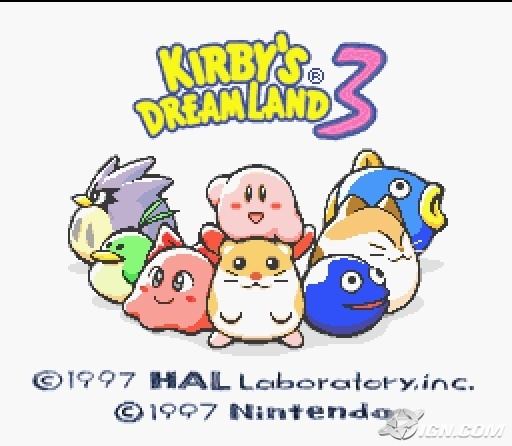 | ||||||||||||||||||||||||||||||||||
Similar Kirby games, HAL Laboratory games, Platform games | ||||||||||||||||||||||||||||||||||
Kirby s dream land 3 in 1 27 23 awesome games done quick 2017 part 125
Kirby's Dream Land 3, known as Hoshi no Kirby 3 (星のカービィ3, Hoshi no Kābī Surī, lit. "Kirby of the Stars 3") in Japan, is the fifth platformer video game starring Kirby. Specifically, it is the third game under the Kirby's Dream Land name. Although the first two games were largely unrelated, Dream Land 3 features many similar characters to Dream Land 2. Kirby 64: The Crystal Shards was the sequel to this game.
Contents
- Kirby s dream land 3 in 1 27 23 awesome games done quick 2017 part 125
- Cgrundertow kirby s dream land 3 for super nintendo video game review
- Plot
- Gameplay
- Kirbys allies
- Visuals
- Reception
- References
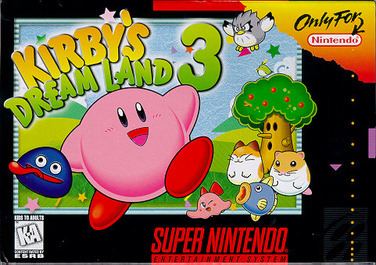
Kirby's Dream Land 3 was the last game published by Nintendo for the Super NES in North America. Problems with the game's PAL conversion prevented it from being released in Europe and Australia for many years; it was finally released for the Virtual Console in those regions in the form of an import from North America on July 24, 2009 for the Wii and on July 25, 2013 for the Wii U. The game was re-released on the Virtual Console in North America on January 5, 2009 for the Wii and on May 8, 2013 for the Wii U and in Japan on April 28, 2009 for the Wii and on May 8, 2013 for the Wii U. It was also included along with 5 other Kirby games in the Wii collection for Kirby's 20th anniversary, Kirby's Dream Collection.
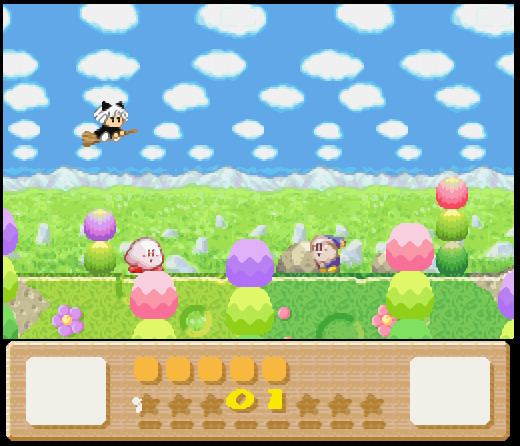
Cgrundertow kirby s dream land 3 for super nintendo video game review
Plot
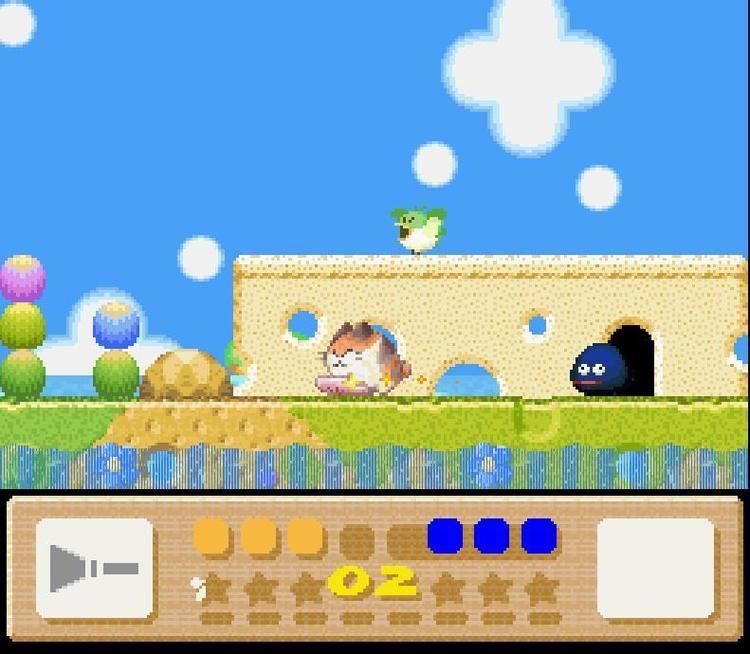
After the events of Kirby's Dream Land 2, Kirby and Gooey are on a fishing trip, when all of a sudden, Dark Matter appears and shatters the planet's rings. He then proceeds to possess various Dream-Landers, including King Dedede. Kirby and Gooey then team up with Rick, Coo, and Kine, as well as new characters Pitch, ChuChu, and Nago.

Two endings exist for the game, based on whether the player has collected all the Heart Stars. If the player has not collected all the stars, Kirby and his friends fight King Dedede, who is possessed by Dark Matter. Once Dedede is defeated once, Dark Matter begins to reveal himself, and Kirby must fight Dedede for a second consecutive time. After Dark Matter is defeated, Kirby and Gooey set off on the journey home, only to pause hesitantly at several points along the way. At the end of the credits, the camera pans up to focus on a huge, shadowed orb with one massive eye. This mysterious figure is Zero, the ultimate leader of the Dark Matter Army.
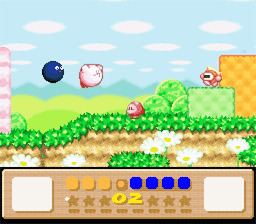
If the player has collected all the stars, the player proceeds to fight Dedede as normal. However, Dark Matter then emerges and flies into the atmosphere, with Kirby in hot pursuit. After a climactic battle with Dark Matter, Zero himself emerges, leading to a long and difficult battle. After Zero is defeated, peace is finally restored to the universe.
Gameplay
The game's platforming mechanics are very similar to most other Kirby games, as is Kirby's skillset. Kirby is able to jump, duck, slide, fly (by inflating himself), as well as perform his signature move: inhaling enemies. When Kirby inhales an enemy, it can be spit back out as a projectile, or swallowed. Normally this has no effect on Kirby, although specific enemies grant Kirby copy abilities, a staple of the Kirby games. Copy abilities replace Kirby's standard inhaling move with a special attack, depending on the enemy Kirby ate. For example, swallowing a fire-based enemy allows Kirby to become a fireball.
Zero is the game's secret and true final boss; defeating him is key in achieving the best ending. Zero takes the form of a giant eye with a red iris, and is responsible for leading the Dark Matter invasion of Dreamland. Zero is famous for being a rare example of graphic violence in a first-party Nintendo game - Zero fights Kirby by opening cuts on his sclera and shooting blood out of the cuts at him. When his health is drastically weakened, his iris rips out from the rest of his body, with blood flying everywhere as it does so. The ruined body, complete with a vicious gash to its front from where the eye burst out trails away, and the final phase of the fight begins, which involves Zero ramming Kirby to injure him. Although he is eventually defeated, Zero reappears in Kirby 64 as 'Zero Two', retaining his ability to spit blood and his motif as a giant eye. As a reference to his previous fight with Kirby, Zero Two wears two large plasters on the top of his 'head', covering the wound left from his iris bursting out of his body in the earlier fight.
Kirby's allies
At any time during play, Kirby can summon Gooey—a blue, long-tongued blob first seen in Dream Land 2. Doing so costs Kirby two hit points. When controlled by the computer or also a second human player, Gooey's abilities are similar to Kirby's: He can swallow enemies using his long tongue, then either spit them out or copy their abilities to a limited extent. Gooey's tongue is also capable of obtaining items similarly to Kirby's inhale, though it is also capable of grabbing stars, which Kirby would need to touch in order to obtain. Kirby can also inhale Gooey and swallow him, reclaiming his two hit points.
In addition to Gooey, Kirby can team up with any one of his six other Animal Friends, three of which were introduced in the previous game in the series. This friend mechanic allows Kirby to be ridden, carried or rolled, enabling new team-based abilities, as well as variations of Kirby's copy abilities. The friends Kirby can team up with are:
Numerous puzzles in the game make use of the Animal Friends' different gameplay styles, and usually require the player to master them in order to be completed. For example, one mission that has Kirby escort Rick to the end of the level features numerous high walls to scale and large gaps bridged by enemies to stomp on, and another mission makes Kirby use the Clean ability with Pitch to water some flowers. In many other cases, however, the Animal Friends serve as a supplement to the gameplay with the purpose of aiding the player. Additionally, each world features one Heart Star mission requiring that Kirby escort an Animal Friend to an acquaintance of theirs at the end of the level.
Visuals
Kirby's Dream Land 3 uses a mode of the SNES termed "pseudo high-resolution" (which allows for color blending between two adjacent pixels) to blend dithered sprites.
The cartridge also takes advantage of SA-1 technology to process game data at a faster rate, which was necessary for the large number of bitmaps and special effects used by faster releases.
Reception
Kirby's Dream Land 3 received mixed to positive reception from both critics and fans. IGN gave Dream Land 3 a fairly positive review of the Virtual Console re-release, "It's not Super Star. But once you get past that, you can appreciate Dream Land 3 for what it is -- a direct, numbered follow-up to the series that started on the Game Boy." Nintendo Life initially gave the game a 6 out of 10, criticizing the lack of difficulty but praising the stylized graphics. However, a different reviewer for the same website gave the Virtual Console re-release a 7 out of 10, calling Dream Land 3 a "lovable gaming experience" and a "worthy sequel."
